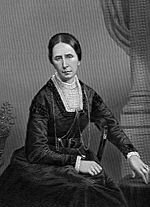- Minuscule 538
-
New Testament manuscripts
papyri • uncials • minuscules • lectionariesMinuscule 538 Text Gospels † Date 12th century Script Greek Now at University of Michigan Size 15.2 cm by 11 cm Type Byzantine text-type, Kx Category V Hand neatly written Note marginalia Minuscule 538 (in the Gregory-Aland numbering), ε 335 (von Soden),[1] is a Greek minuscule manuscript of the New Testament on a parchment. Dated palaeographically to the 12th or 13th century.[2] Formerly it was labelled as Wd and 552 (Scrivener). The manuscript is lacunose. It was adapted for liturgical use.
Contents
Description
The codex contains the text of the four Gospels, on 212 parchment leaves (15.2 cm by 11 cm) with some lacunae (Matthew 1:1-12:41; 15:14-30; Mark 14:9-20; John 1:1-15).[3] It is written in one column per page, 24 lines per page in minuscule letters.[2] The letters are neatly written.[3]
The text is divided according to the κεφαλαια (chapters), whose numbers are given at the margin, and their τιτλοι (titles of chapters) at the top of the pages. There is also a division according to the Ammonian Sections (in Mark 241 Sections - the last in 16:20), with references to the Eusebian Canons (written at the margin below Ammonian Section numbers).[3][4]
The tables of the κεφαλαια (tables of contents) are placed before each Gospel, portrait of the Saint Mark,[5] It contains lectionary markings at the margin (for liturgical use), Menologion (fragments), and subscriptions at the end of each Gospel, with numbers of stichoi.[3] The manuscript was bound and numbered later.
Some leaves were cut in a trapezoidal shape. Gospel order is mixed with various leaves misplaced in other areas of the manuscript (folio 153 recto has John 1:15).
Text
The Greek text of the codex is a representative of the Byzantine text-type. Hermann von Soden classified it as a member of the textual family Kx.[6][7] In Mark and Luke it closer to K1.[8] Aland placed it in Category V.[9] The manuscript has some non-Byzantine elements. It has some textual affinities to the early versions of the Gospels.[8] According to the Claremont Profile Method it represents the textual family Kx in Luke 1 and Luke 20. In Luke 10 it has mixed Byzantine text.[7]
History
The manuscript was brought from Janina (Epirus) between 1870 and 1872 together with the codices 532-546 and bought by Baroness Burdett-Coutts (1814-1906), a philanthropist.[3] It was presented by Burdett-Coutts to Sir Roger Cholmely's School, and was housed at the Highgate (Burdett-Coutts II. 18), in London.[3]
It was added to the list of the New Testament manuscripts by F. H. A. Scrivener (552) and C. R. Gregory (538).[4] Gregory saw it in 1883.[3]
The manuscript was examined and collated by Scrivener in his Adversaria critica sacra.[10] It was digitalised by the CSNTM.[11]
Currently the codex is housed at the University of Michigan (Ms. 18), in Ann Arbor.[2]
See also
References
- ^ Gregory, Caspar René (1908). Die griechischen Handschriften des Neuen Testament. Leipzig: J. C. Hinrichs'sche Buchhandlung. p. 67. http://www.archive.org/stream/diegriechischen00greggoog#page/n77/mode/2up.
- ^ a b c Aland, Kurt; M. Welte, B. Köster, K. Junack (1994). Kurzgefasste Liste der griechischen Handschriften des Neues Testaments. Berlin, New York: Walter de Gruyter. p. 78. ISBN 3110119862.
- ^ a b c d e f g Gregory, Caspar René (1900). Textkritik des Neuen Testaments. 1. Leipzig: J.C. Hinrichs'sche Buchhandlung. p. 200. http://www.archive.org/details/textkritikdesne00greggoog.
- ^ a b Scrivener, Frederick Henry Ambrose; Edward Miller (1894). A Plain Introduction to the Criticism of the New Testament. 1 (4 ed.). London: George Bell & Sons. p. 254.
- ^ F. H. A. Scrivener, Adversaria critica sacra (Cambridge and London, 1893), pp. XLV-XLVI.
- ^ Hermann von Soden, Die Schriften des Neues Testaments, I, II (Berlin, 190), p. 750.
- ^ a b Wisse, Frederik (1982). The profile method for the classification and evaluation of manuscript evidence, as Applied to the Continuous Greek Text of the Gospel of Luke. Grand Rapids: William B. Eerdmans Publishing Company. p. 62. ISBN 0-8028-1918-4.
- ^ a b William Merritt Read, Michigan Manuscript 18 of The Gospels. Seattle, Univ. of Washington Press, 1942, p. 80.
- ^ Aland, Kurt; Barbara Aland; Erroll F. Rhodes (trans.) (1995). The Text of the New Testament: An Introduction to the Critical Editions and to the Theory and Practice of Modern Textual Criticism. Grand Rapids: William B. Eerdmans Publishing Company. p. 139. ISBN 978-0-8028-4098-1.
- ^ F. H. A. Scrivener, Adversaria critica sacra (Cambridge 1893).
- ^ Images of Minuscule 538 at the CSNTM
Further reading
- F. H. A. Scrivener, Adversaria critica sacra (Cambridge and London, 1893), pp. XLV-XLVI. (as l)
- K. W. Clark, A Descriptive Catalogue pf Greek New Testament Manuscripts in America (Chicago, 1937), pp. 285-286.
- William Merritt Read, A Collation of the University of Michigan Manuscript no. 18 of the Four Gospels (Seattle, University of Washington Press, 1942.
External links
- Images of Minuscule 538 at the CSNTM
- William Merritt Read, Michigan Manuscript 18 of The Gospels. Seattle, Univ. of Washington Press, 1942.
Minuscule 532 · Minuscule 533 · Minuscule 534 · Minuscule 535 · Minuscule 536 · Minuscule 537 · Minuscule 538 · Minuscule 539 · Minuscule 540 · Minuscule 541 · Minuscule 542 · Minuscule 543 · Minuscule 544 · Minuscule 545 · Minuscule 546 · Minuscule 699 · Minuscule 876 · Lectionary 170 · Lectionary 214 · Lectionary 215 · Lectionary 216 · Lectionary 217 · Lectionary 218 · Lectionary 219 · Lectionary 220 · Lectionary 221 · Lectionary 222 · Lectionary 223 · Lectionary 224 · Lectionary 225 · Lectionary 226 · Lectionary 227 · Lectionary 228 · Lectionary 313 · Lectionary 314 · Lectionary 315 ·
Categories:- Greek New Testament minuscules
- 12th-century biblical manuscripts
Wikimedia Foundation. 2010.

